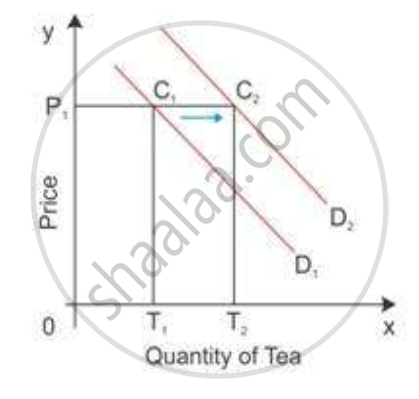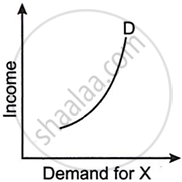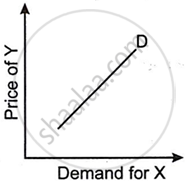Advertisements
Advertisements
Question
How does change in the price of a substitute good affect the demand of the given good? Explain with the help of an example.
Solution
Substitute goods are goods which can be purchased in place of each other. The demand for
a commodity is in relation to the price of its substitute good. Assume tea and coffee as two
substitute goods. D1 is the demand curve for the demand for tea in the diagram.
When the price of tea is OP1, the quantity demanded is OT1 as shown in Fig (a). If there is an
increase in the price of the substitute good coffee, then the demand curve for tea shifts to
the right. Now, the consumer is willing to buy the P1C2 quantity of tea which is equal to OT2.
Greater the purchase of a commodity at its constant price points to a situation of increase
or forward shift in the demand curve. The consumer demand curve shifts from D1 to D2,
consuming more of tea even when its price is constant.

APPEARS IN
RELATED QUESTIONS
Explain the law of demand with its assumptions.
Distinguish between individuals demand and market demand.
Good Y is a substitute of good X. The price of Y falls. Explain the chain of effects of this change in the market of X.
What does a rightward shift of demand curve indicate?
State with reason, whether you Agree or Disagree with the following statement.
The demand curve slopes downward from left to right.
Do you agree with the following statement? Give reason
There are no exceptions to the law of demand.
Do you agree with the following statement? Give reason
State and explain the law of demand.
State with reasons whether you ‘agree’ or ‘disagree’ with the following statement.
Demand curve slopes downward from left to right.
The shape of supply curve is ______
Identify the correctly matched items from Column I to that of Column II:
| Column I | Column II |
| (1) Demand Curve of Perfect Competition | (a) V-shaped Curve |
| (2) Demand Curve of Monopoly | (b) U-shaped Curve |
| (3) Demand Curve of Monopolistic Competition | (c) Upward rising |
| (4) Demand Curve of Oligopoly | (d) In-determinant |
Assertion (A): The demand curve is downward sloping.
Reason (R): The income effect means with a fall in the price of a good, the consumer's real income or purchasing power rises and he demands more units of the good.
In case of perfect competition, AR curve is:
Explain why the demand curve slopes downwards.
- Assertion (A): The demand curve slopes downwards.
- Reasoning (R): A fall in the price of goods increases the real income of the consumer enabling him/her to buy more.
Study the following table and answer the questions:
| Price of Ice Cream (₹) | Quantity Supplied | Market Supply | ||
| Seller A | Seller B | Seller C | (A + B + C) | |
| 50 | 0 | 2 | 5 | 7 |
| 100 | 1 | `square` | 10 | 15 |
| 150 | `square` | 6 | 15 | 23 |
| 200 | 3 | 8 | 20 | `square` |
| 250 | 4 | 10 | `square` | 39 |
Questions:
- Complete the above table.
- State whether the following statements are True or False.
(a) Market supply has a direct relation to price.
(b) As the price rises from ₹50 to ₹250, market supply rises from 7 to 39. This indicates an increase in supply.
Figures (A), (B) and (C) given below represent different types of Demand curves.
 |
 |
 |
| (A) | (B) | (C) |
What kind of goods do each of these Demand curves represent? Give a reason for each of the curves.
Draw a straight-line demand curve joining both the axes. Indicate the following on the demand curve.
Elasticity of demand is equal to zero
